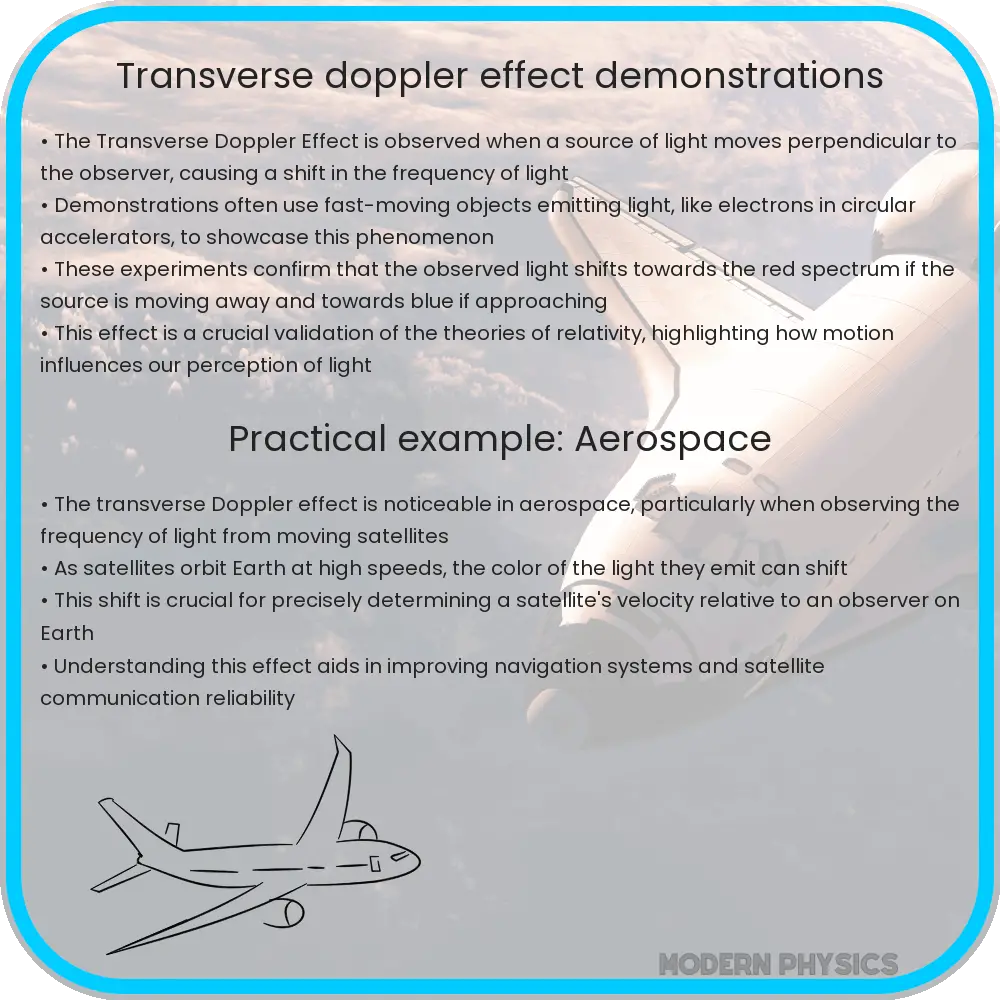Explore the Transverse Doppler Effect in relativity with insights on its proofs, demos, practical applications, and significance in modern physics.

Understanding the Transverse Doppler Effect in Relativity
The Transverse Doppler Effect is a fascinating phenomenon in the realm of physics, specifically within the theory of relativity. It differs significantly from the classical Doppler effect known in acoustics and is a direct consequence of Albert Einstein’s theory of Special Relativity. This effect occurs when a source of light moves perpendicularly to the observer’s line of sight. Unlike the classic Doppler effect, which involves changes in frequency due to relative motion along the line of sight, the Transverse Doppler Effect is observed even when the source is moving sideways relative to the observer.
Experimental Verification of the Transverse Doppler Effect
One of the most compelling aspects of the Transverse Doppler Effect is its experimental verification, which serves as a crucial proof of the theory of Special Relativity. The Ives-Stilwell experiment, conducted in the early 20th century, is a prominent example. It utilized fast-moving hydrogen ions and observed the frequency shift of light emitted perpendicular to their motion. The results were in remarkable agreement with the predictions made by Special Relativity, thus providing concrete evidence for the theory.
Mathematical Expression of the Transverse Doppler Effect
The mathematical formulation of the Transverse Doppler Effect is elegantly derived from the Lorentz transformations. The frequency shift \(\Delta \nu\) can be expressed as:
\[\Delta \nu = \nu’ – \nu = \nu \left( \sqrt{1 – \frac{v^2}{c^2}} – 1 \right)\]
where \(\nu’\) is the observed frequency, \(\nu\) is the emitted frequency, \(v\) is the velocity of the source perpendicular to the line of sight, and \(c\) is the speed of light. This equation underscores the relativistic effect of time dilation on the perceived frequency of the light.
Applications and Significance
The implications of the Transverse Doppler Effect extend beyond theoretical physics. It has practical applications in astrophysics, particularly in the analysis of light emitted from rapidly moving celestial bodies. Additionally, this effect plays a role in modern technologies like the Global Positioning System (GPS), where relativistic corrections are essential for accurate positioning.
Understanding the Transverse Doppler Effect not only provides insight into the behavior of light and motion but also reinforces the fundamental principles of Special Relativity. Its discovery and subsequent verification stand as a testament to the predictive power of theoretical physics, bridging the gap between abstract concepts and observable reality.
Challenges in Observing the Transverse Doppler Effect
Despite its theoretical importance, observing the Transverse Doppler Effect in practical scenarios poses significant challenges. The effect is relatively subtle compared to the classic Doppler effect and requires extremely high velocities and precise measurement instruments. In laboratory conditions, replicating such high velocities and accurately measuring the resulting frequency shift demand advanced technological setups. These challenges highlight the complexity involved in testing and verifying the predictions of Special Relativity in experimental settings.
Relativity in Everyday Life
While the Transverse Doppler Effect might seem esoteric, it has surprising relevance in our daily lives. In systems like the GPS, the effect of relativity, both Special and General, is accounted for. The satellites in the GPS constellation move at high speeds and are in a different gravitational field compared to receivers on Earth. Without adjustments for these relativistic effects, including the Transverse Doppler Effect, the accuracy of GPS would degrade significantly over time, affecting everything from navigation to telecommunications.
Education and Further Research
The study of the Transverse Doppler Effect is not only important for professional physicists but also serves as an educational tool. It provides students and enthusiasts with a tangible example of the effects predicted by the theory of relativity. In academic settings, this phenomenon can be introduced to illustrate the fundamental concepts of time dilation and relativistic motion. Furthermore, ongoing research in this area continues to refine our understanding of relativistic physics, opening new avenues for exploration in both theoretical and applied physics.
Conclusion
The Transverse Doppler Effect, a subtle yet profound phenomenon, is a cornerstone in the edifice of modern physics. Its discovery and verification have greatly contributed to our understanding of Special Relativity, challenging and expanding our notions of time, space, and motion. From its theoretical significance to its practical applications in technology like GPS, this phenomenon bridges the gap between abstract scientific principles and tangible real-world effects. As technology advances, we can expect even more precise measurements and applications of this fascinating aspect of physics, continuing to test and affirm the incredible predictions of Einstein’s theories.
